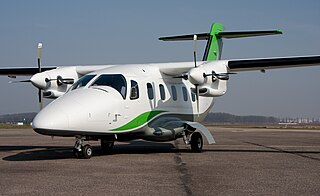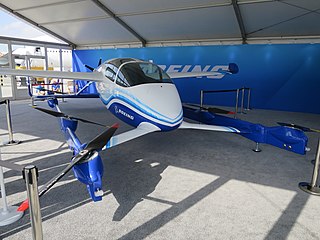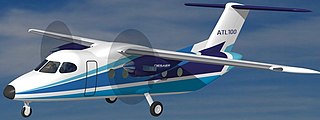
The British Aerospace 146 is a short-haul and regional airliner that was manufactured in the United Kingdom by British Aerospace, later part of BAE Systems. Production ran from 1983 until 2001. Manufacture by Avro International Aerospace of an improved version known as the Avro RJ began in 1992. A further-improved version with new engines, the Avro RJX, was announced in 1997, but only two prototypes and one production aircraft were built before production ceased in 2001. With 387 aircraft produced, the Avro RJ/BAe 146 is the most successful British civil jet airliner programme.

The Tupolev Tu-334 was a Russian short-to-medium range airliner project that was developed to replace the ageing Tu-134s and Yak-42s in service around the world. The airframe was based on a shortened Tu-204 fuselage and a scaled-down version of that aircraft's wing. Unlike the Tu-204, however, the Tu-334 has a T-tail and engines mounted on the sides of the rear fuselage instead of under the wings. With the nationalisation of the Russian aircraft companies in 2009 to form United Aircraft Corporation it was decided not to continue with the programme.

The General Electric GE36 was an experimental aircraft engine, a hybrid between a turbofan and a turboprop, known as an unducted fan (UDF) or propfan. The GE36 was developed by General Electric Aircraft Engines, with its CFM International equal partner Snecma taking a 35 percent share of development. Development was cancelled in 1989.

An electric aircraft is an aircraft powered by electricity, almost always via one or more electric motors which drive propellers. Electricity may be supplied by a variety of methods, the most common being batteries. Electrically powered model aircraft have been flown at least since the 1970s and were the forerunners of the small unmanned aerial vehicles (UAV) or drones, which in the twenty-first century have become widely used for many purposes.

The Progress D-27 is a three-shaft propfan engine developed by Ivchenko Progress. The gas generator was designed using experience from the Lotarev D-36 turbofan. The D-27 engine was designed to power more-efficient passenger aircraft such as the abandoned Yakovlev Yak-46 project, and it was chosen for the Antonov An-70 military transport aircraft. As of 2019, the D-27 is the only contra-rotating propfan engine to enter service.

The Bell YAH-63 was an experimental attack helicopter for the Advanced Attack Helicopter (AAH) competition. Hughes' Model 77/YAH-64, later developed into the AH-64 Apache, was selected over Bell's entry.

The Grob G180 SPn is a low-wing twin-engined composite corporate jet designed and built by German aircraft manufacturer Grob Aerospace. Development was suspended during 2008 in response to the Grob's insolvency; since then, multiple efforts have been made to re-launch the programme.

The Evektor EV-55 Outback is a twin-engine turboprop aircraft designed and built in the Czech Republic by Evektor-Aerotechnik. The prototype first flew on 24 June 2011. The project's development was suspended in March 2017.

The Peak Aerospace Me 109R is a family of German replica warbird ultralight aircraft that was designed by Tassilo Bek, and originally produced by Peak Aerospace of Pasewalk. The company since changed its name to Classic Planes GmbH. The design, first flown in 1991, is an 80% scale replica of the Second World War Messerschmitt Bf 109 and is supplied as a kit for amateur construction or as a complete ready-to-fly-aircraft.

The Bye Aerospace eFlyer 2 is a light electric aircraft designed and under development by Bye Aerospace of Denver, Colorado.
The CFM Air Dardo is an Italian ultralight aircraft that was designed by CFM Air of Cirié, introduced at the AERO Friedrichshafen show in 2014.

Zunum Aero was an aircraft manufacturer startup based in Kirkland, Washington. Backed by Boeing HorizonX and JetBlue Technology Ventures, the company worked from 2013 to 2018 on a proposed family of hybrid electric regional aircraft of up to 50 seats.

The Eviation Alice is a projected electric aircraft designed to accommodate nine passengers and two crew members. Currently under development, its construction incorporates 95% composite material, is powered by two electric motors, and has a T-tail.
The Bye Aerospace eFlyer4, originally named the Bye Aerospace Sun Flyer 4, is an American electric aircraft under development by Bye Aerospace of Denver, Colorado. The design was announced at the 2017 AirVenture airshow in Oshkosh, Wisconsin. The aircraft will be type certified and supplied complete and ready-to-fly.

The Boeing Passenger Air Vehicle (PAV) is an American autonomous personal air vehicle prototype developed by the Boeing NeXt division of Boeing with the assistance of Aurora Flight Sciences.

The XTI TriFan 600 is a vertical takeoff and landing aircraft currently under development by XTI Aircraft Company.

The VoltAero Cassio is a family of hybrid electric aircraft being developed by startup company VoltAero. The company plans to produce three configurations of the Cassio aircraft: the four-place Cassio 330, the six-place Cassio 480, and the ten-place Cassio 600.
A hybrid electric aircraft is an aircraft with a hybrid electric powertrain. As the energy density of lithium-ion batteries is much lower than aviation fuel, a hybrid electric powertrain may effectively increase flight range compared to pure electric aircraft. By May 2018, there were over 30 hybrid electric aircraft projects, and short-haul hybrid-electric airliners were envisioned from 2032.

The Desaer ATL-100 is a twin-turboprop, high-wing, utility aircraft under development by Desaer in Brazil and by CEiiA in Portugal.
The Pipistrel Nuuva V300 is an unmanned hybrid-electric VTOL cargo aircraft currently under development by Pipistrel and projected to be released in 2023. The aircraft has eight electric motors driving propellers providing lift as well as a single internal combustion engine driving a propeller providing thrust. The company claims that the aircraft will be able to operate with a typical cargo weight of 300 kg (661 lb) and a typical range of 300 km (162 nmi). In October 2020 the company announced that the aircraft would implement a Honeywell fly-by-wire system.















